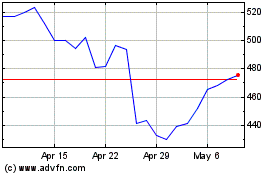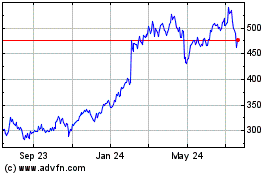By Mark Hulbert
The stock market's return over the next decade is likely to be
well below historical norms.
That is the unanimous conclusion of eight stock-market
indicators with what I consider the most impressive track records
over the past six decades. The only real difference between them is
the extent of their bearishness. (See chart below.)
Of course, it is impossible to say that there aren't other
indicators with even better long-term records than these eight. But
I'm not aware of any.
To illustrate the bearish story told by each of these
indicators, consider the projected 10-year returns to which these
indicators' current levels translate. The most bearish projection
of any of them was that the S&P 500 would produce a 10-year
total return of 3.9 percentage points annualized below inflation.
The most bullish was 3.6 points above inflation.
Even the bullish end of that range is more than 3 annualized
percentage points below the stock market's inflation-adjusted
return over the past 200 years.
The most accurate of the indicators I studied was created by the
anonymous author of the blog Philosophical Economics. It is now as
bearish as it was right before the 2008 financial crisis,
projecting an inflation-adjusted S&P 500 total return of just
0.8 percentage point above inflation. Ten-year Treasurys can
promise you that return with far less risk.
Bubble flashbacks
The only other time it was more bearish (during the period since
1951 for which data are available) was at the top of the
internet-stock bubble.
The blog's indicator is based on the percentage of household
financial assets -- stocks, bonds and cash -- that is allocated to
stocks. This proportion tends to be highest at market tops and
lowest at market bottoms.
According to data collected by Ned Davis Research from the
Federal Reserve, this percentage currently looks to be at 56.3%,
more than 10 percentage points higher than its historical average
of 45.3%. At the top of the bull market in 2007, it stood at
56.8%.
Ned Davis, the eponymous founder of Ned Davis Research, calls
the indicator's record "remarkable." I can confirm that its record
is superior to seven other well-known valuation indicators analyzed
by my firm, Hulbert Ratings.
To figure out how accurate an indicator has been, we calculated
a statistic known as the R-squared, which ranges from 0% to 100%
and measures the degree to which one data series explains or
predicts another.
In this case, zero means that the indicator has no meaningful
ability to predict the stock market's returns after inflation over
the next 10 years. On the other hand, a reading of 100% would mean
that the indicator is a perfect predictor.
Since 1954, according to our analysis, the Philosophical
Economics indicator had an R-squared of 61%. In the messy world of
stock-market prognostication, that is statistically significant.
Our analysis begins in that year because that is the earliest date
for which data are available for all of the other indicators that
we studied.
The other seven
So, here's a look at those other indicators back to the 1950s,
listed in descending order of their R-squareds:
-- The Q ratio, with an R-squared of 46%. This ratio -- which is
calculated by dividing market value by the replacement cost of
assets -- was the outgrowth of research conducted by the late James
Tobin, the 1981 Nobel laureate in economics.
-- The price/sales ratio, with an R-squared of 44%, is
calculated by dividing the S&P 500's price by total per-share
sales of its 500 component companies.
-- The Buffett indicator was the next-highest, with an R-squared
of 39%. This indicator, which is the ratio of the total value of
equities in the U.S. to gross domestic product, is so named because
Berkshire Hathaway Inc.'s Warren Buffett suggested in 2001 that is
it "probably the best single measure of where valuations stand at
any given moment."
-- CAPE, the cyclically adjusted price/earnings ratio, came next
in the ranking, with an R-squared of 35%. This is also known as the
Shiller P/E, after Robert Shiller, the Yale finance professor and
2012 Nobel laureate in economics, who made it famous in his 1990s
book "Irrational Exuberance."
The CAPE is similar to the traditional P/E except the
denominator is based on 10-year average inflation-adjusted earnings
instead of focusing on trailing one-year earnings.
-- Dividend yield, the percentage that dividends represent of
the S&P 500 index, sports an R-squared of 26%.
-- Traditional price/earnings ratio has an R-squared of 24%.
-- Price/book ratio -- calculated by dividing the S&P 500's
price by total per-share book value of its 500 component companies
-- has an R-squared of 21%.
According to various tests of statistical significance, each of
these indicators' track records is significant at the 95%
confidence level that statisticians often use when assessing
whether a pattern is genuine.
However, the differences between the R-squareds of the top four
or five indicators I studied probably aren't statistically
significant, I was told by Prof. Shiller. That means you're
overreaching if you argue that you should pay more attention to,
say, the average household equity allocation than the price/sales
ratio.
The bulls' response
What do the bulls say about all this? To find out, I turned to
Jeremy Siegel, a finance professor at the Wharton School of the
University of Pennsylvania.
Prof. Siegel is perhaps best known as the author of "Stocks for
the Long Run," in which he argues that buying and holding equities
for the long term is the best advice for most investors.
In an interview, Prof. Siegel questioned the strength of these
indicators' statistical foundation. He says their historical
records contain peculiarities that traditional statistical tests
don't adequately correct for. Once corrected, Prof. Siegel suspects
that their R-squareds would be significantly lower.
Prof. Siegel also questions whether these indicators are really
as bearish as they seem. Among the theoretical objections he lodged
against these indicators:
-- Accounting-rule changes in the 1990s. After those changes, he
says, readings from the traditional P/E and the Shiller P/E were
higher than before, so their recent levels aren't particularly
comparable to those from previous decades.
-- The Buffett indicator has lost any relevance it may have once
had because of the increasing proportion of U.S. corporate sales
coming from overseas. That dynamic also artificially inflates the
indicator and makes it appear more bearish than it should be, Prof.
Siegel says.
-- The Q ratio provided insight at a time when our economy was
dominated by capital-intensive manufacturing companies, but not
when it is dominated by high-tech information-age firms.
"What is the replacement cost for a Google or a Facebook?" Prof.
Siegel asks rhetorically.
It can't be determined, however, whether correcting for these
issues would transform the message of any of these indicators from
bearish to outright bullish. Prof. Shiller of Yale, for one, says
he isn't aware of any indicator that currently is forecasting
above-average returns over the next decade and sports a
statistically significant record back to at least the 1950s.
Regardless, it is important to emphasize that, no matter how
impressive the statistics underlying the indicators may be, they
don't amount to a guarantee that the stock market will struggle
over the next decade.
After all, as Prof. Siegel reminds us, most of these indicators
have been bearish for years now, even as stocks have enjoyed one of
the most powerful bull markets in history.
Furthermore, even if stocks turn out to be lower in a decade's
time, none of these indicators tells us anything about the path
that the market takes along the way. It might immediately head
south from here, or it could enter a blowoff phase of sharply
higher prices before succumbing to a severe bear market.
A leaf in a hurricane
Calling short-term trends is difficult, if not impossible. For
instance, when it comes to calling one-year returns, Prof. Shiller
said in an interview that he doesn't know of any valuation
indicator with a record extending as far back as the 1950s whose
predictive power is significantly better than zero.
Ben Inker, co-head of the asset-allocation team at GMO, draws an
analogy to a leaf in a hurricane: "You have no idea where the leaf
will be a minute or an hour from now. But eventually gravity will
win out, and it will land on the ground."
Mr. Hulbert is the founder of the Hulbert Financial Digest and a
senior columnist for MarketWatch. He can be reached at
reports@wsj.com.
(END) Dow Jones Newswires
August 05, 2018 22:26 ET (02:26 GMT)
Copyright (c) 2018 Dow Jones & Company, Inc.
Meta Platforms (NASDAQ:META)
Historical Stock Chart
From Mar 2024 to Apr 2024

Meta Platforms (NASDAQ:META)
Historical Stock Chart
From Apr 2023 to Apr 2024
